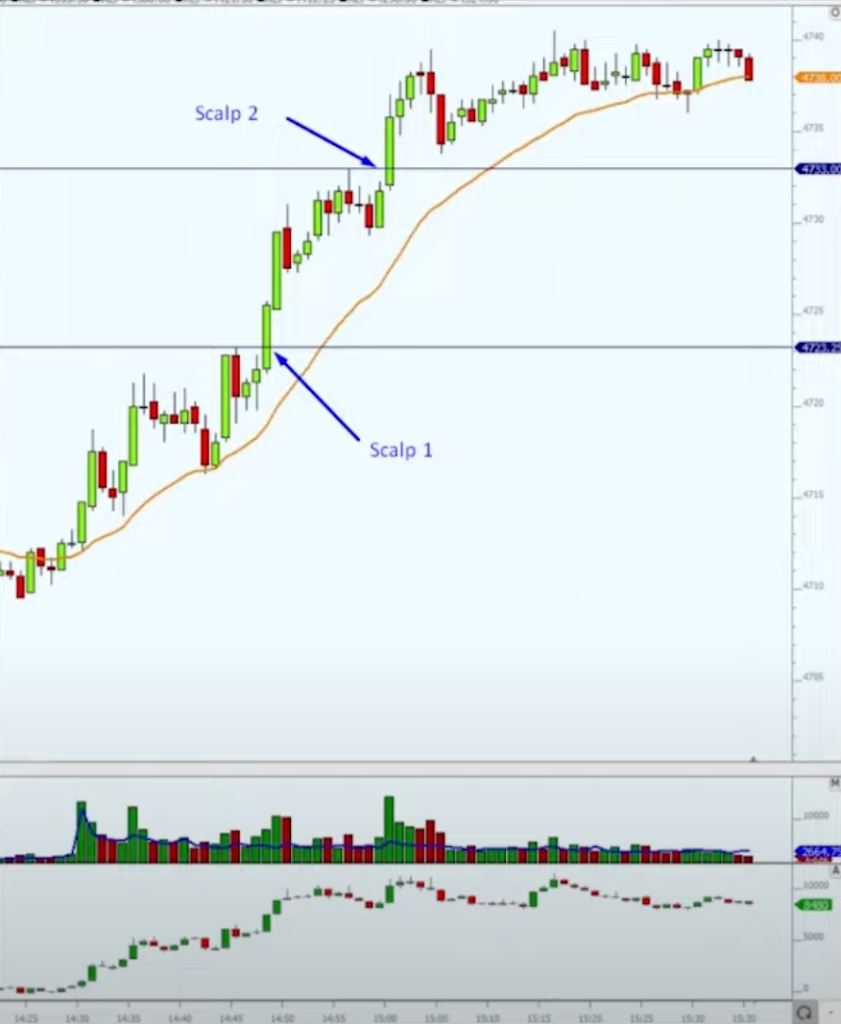Trend Scalping Strategy To Trade S&P500 Introduction
In this blog post, we will be looking at the trend scalping strategy to trade S&P500. Scalping consistently well in such a dynamic and fast pace moving market such as S&P500 requires true mastery. Understanding when is the right time for the scalp and what to look for is crucial. Richard breaks down two simple strategies you can use in your own trading. Focus on a specific location in the market and use the order-flow and that passive bid holding near the break of the highs as your access signal. If you like breakout trades, don’t forget to read one of our previous blog posts: “Trading Gold Breakout Using Market Profile And Price Ladder” where a junior trader builds his position while waiting for the break to fully develop.
This content is based on the video done by Richard.
Trend Scalping Strategy In S&P500
Choosing The Right Strategy For Scalping
One of the crucial and important points in trading the scalping strategy is the understanding under which conditions you can apply this strategy. In this case, we are looking at the trade location where we are breaking into new territory. It can be either new all-time highs (ATHs), breaking into a gap after decent accumulation, or into a level, we have not seen for a long time. Overall, we are choosing the location based on one key assumption: we are hoping that there will be the least amount of resistance possible. Our objective is not to capture massive swing moves. Our main objective is to create a so-called “target-less” trade where the order-flow dynamic and location are our access criteria, and the change of character of the move is our exit criteria. Let me repeat that:
- entry criteria – order-flow dynamics (pressure > pace / panic / FOMO) + location
- exit criteria – personality shift (change of character of the move)
So what do we mean by personality shift? In order to explain that we need to talk about what we are after. Our main objective is to use that momentum, that rush into the new territory that everybody is trying to get in. On the tape, this can be represented by the bid holding well but not only that. Sellers aren’t simply interested at this point in time to hit the bid hard and every time they hit it, the bid gets reloaded. It simply does not back off easily. Sometimes the phrase “sticky bid” is used because the bid is relentless and not fudging a bit. Therefore there are almost no order-flow pullbacks created as we move in our direction. We want to make the most out of the people who are panicking trying to get in, FOMO-ing in by lifting the offer while we wait passively one or two prices below. Yes, you can hit it early, but better to wait for that passive bid to hold. This requires skill. So what is the previously mentioned personality shift? Let’s have a look at the example of such trade and explain it at the end of this post.
Sign up for the FREE Live Training below and get ready to take that next step right now: https://go.elitetraderworkshop.com/Free
Scalping Strategy Context
We are looking at the S&P500 breaking into the ATHs. These are the principles and criteria we want to remember:
- Principles
- Get in as other rush to buy – desperation to not miss out
- Take advantage of urgency to be involved
- Get out when move settles – be humble with what you are doing
- Don’t get caught hold for more than is available
- Criteria
- Know what you are looking for
- Pressure > Pace / Panic / FOMO > giving up when 2 way trade emerges
- Don’t fall into the temptation to hold this longer

Zooming in on a trade, we are looking for the breakout trade. You can find the price ladder action under these links: scalp trade 1 and scalp trade 2.

Now that we have most of the variables, it is time to talk about the personality shift. As you are looking for orders pressure coming in and not backing off, as the selling is getting no traction to the downside, you have clearly one personality of the order-flow. The change in personality comes, when suddenly the bid backs off more rapidly. Suddenly you get the personality shift and that relentless bid is gone. The order-flow dynamic has changed. That change, that change in personality is your EXIT. Time to call it a trade. Needless to say that these trades require a high degree of practice and screen time, but at times can be very effective. Hope this was helpful.
PS: don’t try to scalp every break, be picky and selective, one trade at a time
If you liked this type of content, you might check these videos as well:
- How To Manage & Exit A Failed Breakout Trade
- Sign Of A Breakout About To Fail – Price Ladder Trading
- Market Profile Trading: Better Breakouts with Context and Volume Profiling
Do you like what you have been reading? If you would like to improve your game, definitely check one of our courses that teach you all the techniques presented by AXIA traders from a market profile, footprint, or order-flow. If you are someone who likes to trade the news, we have a great central bank course. And if you are really serious about your future trading career, consider taking AXIA’s 6-Week Intensive High-Performance Trading Course.
Thanks for reading again and until next time, trade well.
JK





